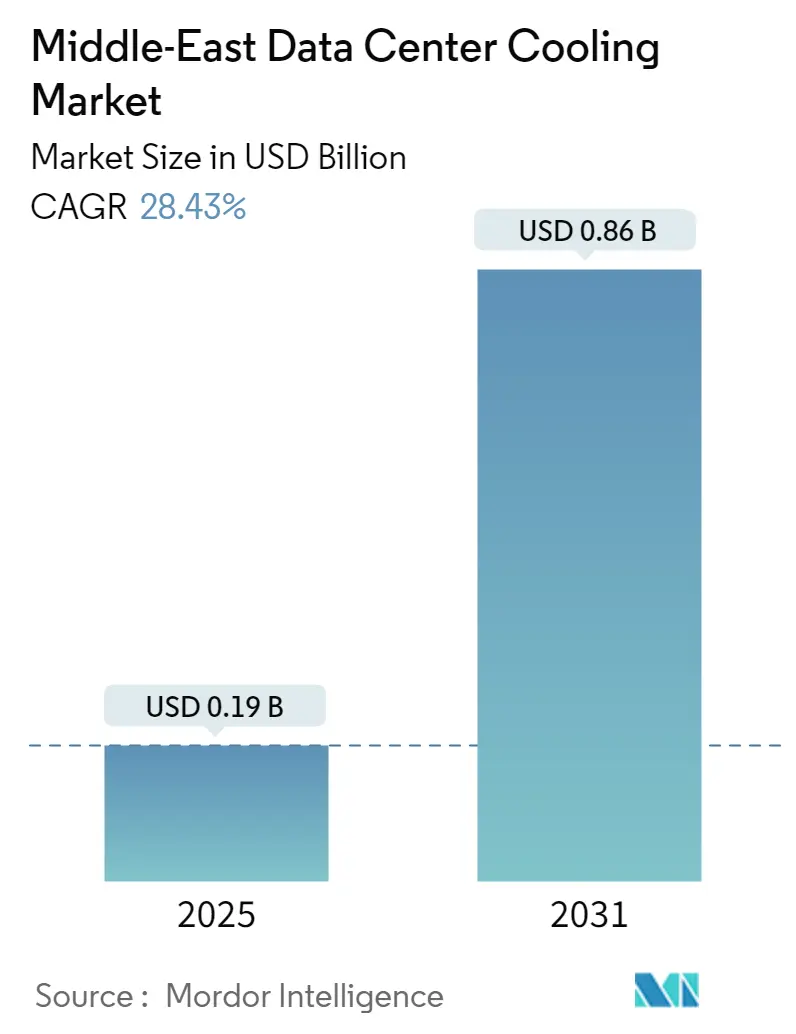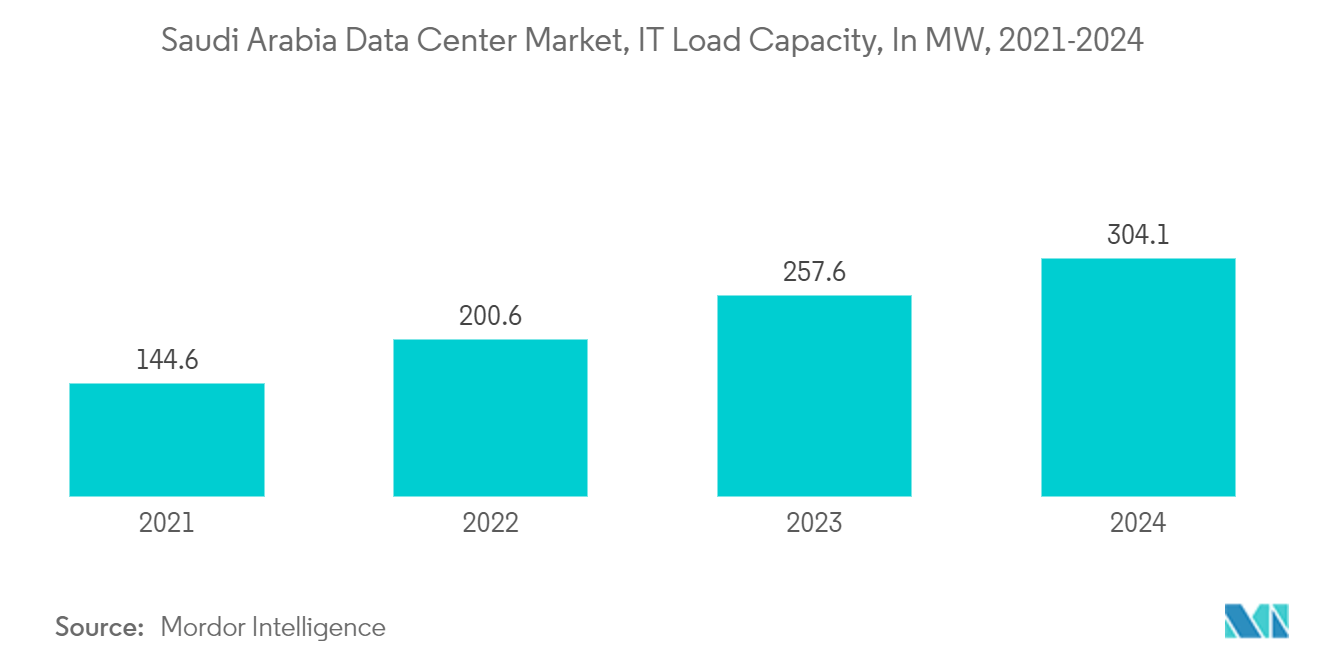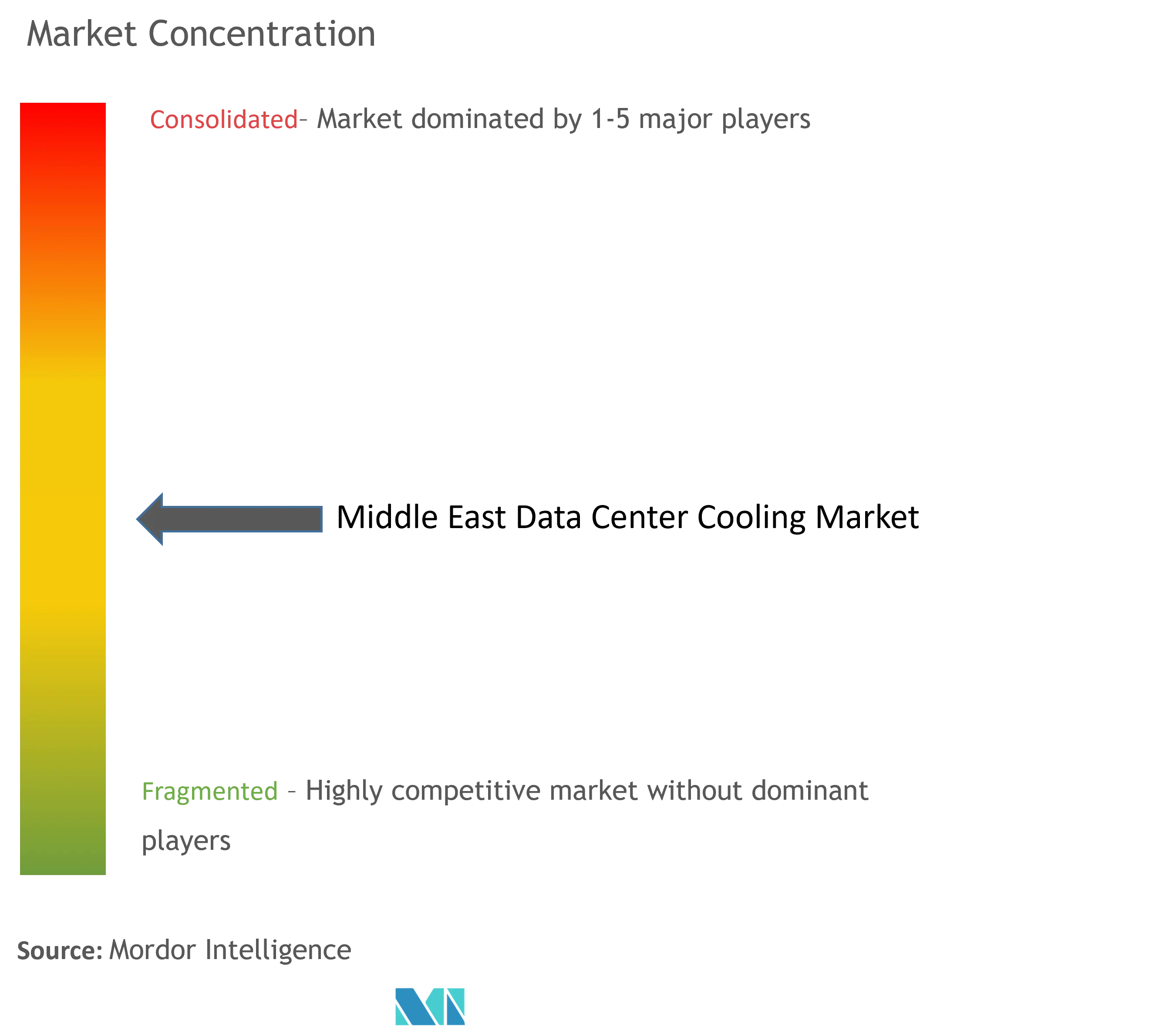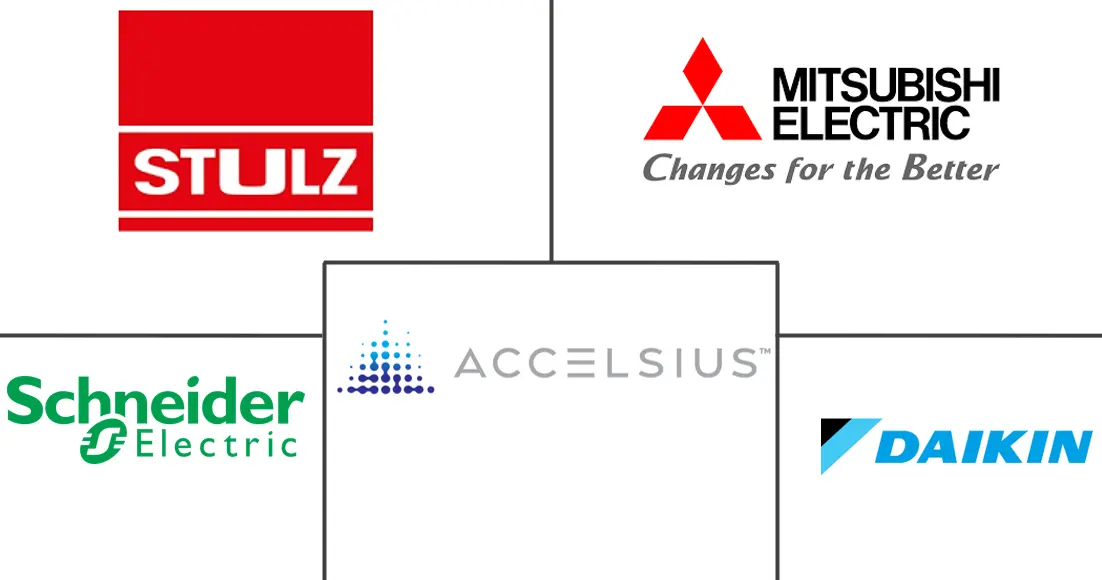Middle-East Data Center Cooling Market Size and Share

Middle-East Data Center Cooling Market Analysis by Mordor Intelligence
The Middle-East Data Center Cooling Market size is estimated at USD 0.19 billion in 2025, and is expected to reach USD 0.86 billion by 2031, at a CAGR of 28.43% during the forecast period (2025-2031).
The Middle East is expected to increase its investment in the data center market. Several factors are facilitating the expansion of data centers in the area. The region's governments' smart city ambitions are driving a shift in how modern communities are built. Cities of the future, supported by digital technologies, are expected to generate massive amounts of data. It is critical to optimize data capture, storage, and processing.
- Under Construction IT Load Capacity: The upcoming IT load capacity of the Middle Eastern data center construction market is expected to reach around 3,534 MW by 2030.
- Under Construction Raised Floor Space: The region's construction of raised floor area is expected to increase 12.6 million sq. ft by 2030.
- Planned Racks: The region's total number of racks to be installed is expected to reach 634K units by 2030. Saudi Arabia is expected to house the maximum number of racks by 2030.
- The Middle East has a Mediterranean climate with hot, dry summers and mild, rainy winters. However, harsh winter conditions continue in the mountains of Iran and Iraq. Precipitation is generally meager, ranging from 350 mm to 750 mm annually. The region is known for being hot and dry. The choice of cooling technology is typically based on the geographic location of the data center.
- Planned Submarine Cables: Close to 26 submarine cable systems are connecting the Middle East, and many are under construction. One submarine cable, Blue, is projected to begin service in 2024. It spans over 4,696 km and has a landing point in Tel Aviv.
Middle-East Data Center Cooling Market Trends and Insights
IT and Telecom Expected to Experience Highest Growth
- To facilitate the transition to knowledge-based economies, the governments of the United Arab Emirates and Saudi Arabia are prioritizing digital initiatives such as 5G. With national consumer initiatives such as digital payments, smartphones are leading the transition to a digital lifestyle. The main drivers of this expansion were larger markets such as Iraq and Egypt, which continued to grow despite their huge current user bases. With the proliferation of smartphones and the use of 5G devices, the amount of raw data is expected to grow. More smartphone users can lead to increased data consumption and increased internet usage. The need for more data centers has increased the demand for cooling equipment in the region.
- In May 2024, Zain KSA unveiled its investment of SAR 1.6 billion, targeting enhancing its infrastructure, 5G network, and digital services ecosystem. This move, part of a broader integrated expansion strategy, underscores Zain KSA's commitment to fostering digital inclusion throughout the Kingdom. The goal is to establish a cutting-edge digital infrastructure prioritizing an exceptional customer experience. With these strategic investments, Zain KSA plans to broaden its 5G network reach from 66 cities to 122 cities and governorates nationwide, prominently including Makkah and the Holy Sites. Notably, Zain KSA is set to become the inaugural telecom operator to achieve comprehensive 5G coverage across all its towers in the Holy Sites.
- The growth of Internet of Things (IoT) devices, cloud adoption, and artificial intelligence (AI) applications are growing in the region, and they require extensive data processing and storage capabilities. For instance, in May 2024, a government-backed research institute in the United Arab Emirates is making significant strides by unveiling a cutting-edge open-source generative AI model. This move garners attention and solidifies the country’s position as a key contender in the global AI landscape.
- In addition, the Saudi Vision 2030, to transform the Saudi Arabian economy and society, is playing a pivotal role in driving the growth of the ICT market in Saudi Arabia. Digital transformation and e-government, the National Industrial Development and Logistics Program, 5G deployment, data governance, and cybersecurity are some key initiatives under Vision 2030 that support the growth of the data center market. Such instances in the market are expected to create more need for data centers, boosting the demand for data center cooling infrastructure manufacturers in the coming years.

Saudi Arabia to Hold Highest Market Share
- Saudi Arabia has emerged as one of the technology hubs in the Middle East and Africa. As big IT and healthcare companies gain access to the market, demand for data centers in the region is soaring so that companies can store their data within borders.
- As creative media content pivots toward content delivery networks, and with the advent of IoT, the expansion of big data, and the introduction of 5G, the appetite for data in Saudi Arabia is surging. Enhanced network connectivity, bolstered by government backing, alongside a rapid uptick in big data and IoT service adoption, are key drivers fueling the Saudi Arabian data center market's expansion.
- Positioned at the crossroads of Asia, Africa, and Europe, Saudi Arabia has leveraged its strategic location to bolster its data center sector. The Red Sea and Arabian Gulf witness a significant influx of subsea cables, further enhancing the region's connectivity. The data center industry, emerging in the early 2000s, primarily caters to the telecom, banking, and finance industries. Over the years, a surge in both local and international investments has catalyzed the sector's growth, prompting the development of Tier-III and Tier-IV certified data centers.
- In March 2024, Zoho Corp., a prominent leader and parent to renowned brands like ManageEngine, Zoho.com, TrainerCentral, and Qntrl, inaugurated its inaugural data centers in the Middle East. Situated in Jeddah and Riyadh, these data centers in Saudi Arabia are now fully operational. Established to comply with the country’s Personal Data Protection Laws (PDPL), these centers ensure that local data remains within the Kingdom's geographical confines.
- Furthermore, in alignment with Saudi Arabia's Vision 2030 objectives, tech behemoths like Google, Microsoft, and IBM have established data centers and are eyeing further expansions. These developments, underscoring the region's surging demand for data centers, consequently spurred an increased need for data center cooling solutions during the study period.

Competitive Landscape
The Middle Eastern data center cooling market is highly competitive and has many significant players, some dominating the market. Market penetration is growing with a strong presence of major players, such as Stulz GmbH, Accelsius, Schneider Electric SE, Daikin Applied Israel, and Mitsubishi Electric Corporation.
In May 2024, Stulz unveiled its latest innovation, the CyberCool Coolant Management and Distribution Unit (CDU), specifically engineered to optimize heat exchange efficiency in liquid cooling solutions. The product line comprises four models, available in two distinct sizes. These units boast an impressive heat exchange capacity, ranging from 345 kW to 1,380 kW. Stulz set the rated water supply temperature for the facility water system at 32°C (89.6°F), with the liquid supply temperature for the technology cooling system pegged at 36°C (96.8°F)
Middle-East Data Center Cooling Industry Leaders
-
Stulz GmbH
-
Accelsius
-
Schneider Electric SE
-
Daikin Applied Israel
-
Mitsubishi Electric Corporation
- *Disclaimer: Major Players sorted in no particular order

Recent Industry Developments
- April 2024: Accelsius, known for its patented NeuCoolTM 2-Phase DTC liquid cooling systems that deliver unmatched high-performance computing and compute density for data center and edge computer operators, announced a strategic partnership with OptiCool Technologies. Together with OptiCool's active RDHx Cool Door, it aims to expedite the development of waterless, direct-to-chip liquid cooling systems, targeting a swiftly growing market.
- March 2024: Vertiv, a prominent provider of critical digital infrastructure and continuity solutions, unveiled a new suite of high-density data center infrastructure solutions. These are tailored to address the rapidly evolving IT landscape's heightened cooling and power requirements. The newly introduced Vertiv 360AI solutions aim to expedite AI adoption, offering pre-engineered infrastructure, digitized management, and comprehensive end-to-end services. With Vertiv 360AI, powering and cooling AI workloads becomes a streamlined process, catering to all scales. The offerings encompass power and cooling systems, enclosures, complete lifecycle services, and advanced digitized management.
Middle-East Data Center Cooling Market Report Scope
Data center cooling is a set of techniques and technologies to maintain optimal operating temperatures in data center environments. Data center cooling is critical as data center facilities house many computer servers and network equipment that generate heat during operation. Efficient cooling systems are used to dissipate this heat and prevent equipment from overheating, ensuring continued reliable operation of the data center. Various methods, such as air conditioning, liquid cooling, and hot/cold aisle containment, are commonly used to control temperature and humidity in data centers.
The Middle Eastern data center cooling market is segmented into cooling technology (air-based cooling (CRAH, chillers and economizers, and cooling towers), liquid-based cooling (immersion cooling and direct-to-chip cooling), and end-user industry (IT and telecommunication, BFSI, government, and media and entertainment), and country. The market sizes and forecasts are provided in terms of value (USD) for all the above segments.
| Air-based Cooling | Chiller and Economizer |
| CRAH | |
| Cooling Tower (covers direct, indirect, and two-stage cooling) | |
| Other Air-based Cooling Technologies | |
| Liquid-based Cooling | Immersion Cooling |
| Direct-to-Chip Cooling | |
| Rear-Door Heat Exchanger |
| Hyperscalers (owned & Leased) |
| Enterprise (On-premise) |
| Colocation |
| IT and Telecom |
| Retail and Consumer Goods |
| Healthcare |
| Media and Entertainment |
| Federal and Institutional agencies |
| Other End-user Industries |
| United Arab Emirates |
| Saudi Arabia |
| Rest of Middle East |
| By Cooling Technology | Air-based Cooling | Chiller and Economizer |
| CRAH | ||
| Cooling Tower (covers direct, indirect, and two-stage cooling) | ||
| Other Air-based Cooling Technologies | ||
| Liquid-based Cooling | Immersion Cooling | |
| Direct-to-Chip Cooling | ||
| Rear-Door Heat Exchanger | ||
| By Type | Hyperscalers (owned & Leased) | |
| Enterprise (On-premise) | ||
| Colocation | ||
| By End-user Industry | IT and Telecom | |
| Retail and Consumer Goods | ||
| Healthcare | ||
| Media and Entertainment | ||
| Federal and Institutional agencies | ||
| Other End-user Industries | ||
| By Country | United Arab Emirates | |
| Saudi Arabia | ||
| Rest of Middle East | ||
Key Questions Answered in the Report
How big is the Middle-East Data Center Cooling Market?
The Middle-East Data Center Cooling Market size is expected to reach USD 0.19 billion in 2025 and grow at a CAGR of 28.43% to reach USD 0.86 billion by 2031.
What is the current Middle-East Data Center Cooling Market size?
In 2025, the Middle-East Data Center Cooling Market size is expected to reach USD 0.19 billion.
Who are the key players in Middle-East Data Center Cooling Market?
Stulz GmbH, Accelsius, Schneider Electric SE, Daikin Applied Israel and Mitsubishi Electric Corporation are the major companies operating in the Middle-East Data Center Cooling Market.
What years does this Middle-East Data Center Cooling Market cover, and what was the market size in 2024?
In 2024, the Middle-East Data Center Cooling Market size was estimated at USD 0.14 billion. The report covers the Middle-East Data Center Cooling Market historical market size for years: 2019, 2020, 2021, 2022, 2023 and 2024. The report also forecasts the Middle-East Data Center Cooling Market size for years: 2025, 2026, 2027, 2028, 2029, 2030 and 2031.
Page last updated on:
Middle-East Data Center Cooling Market Report
Statistics for the 2025 Middle-East Data Center Cooling market share, size and revenue growth rate, created by Mordor Intelligence™ Industry Reports. Middle-East Data Center Cooling analysis includes a market forecast outlook for 2025 to 2031 and historical overview. Get a sample of this industry analysis as a free report PDF download.



